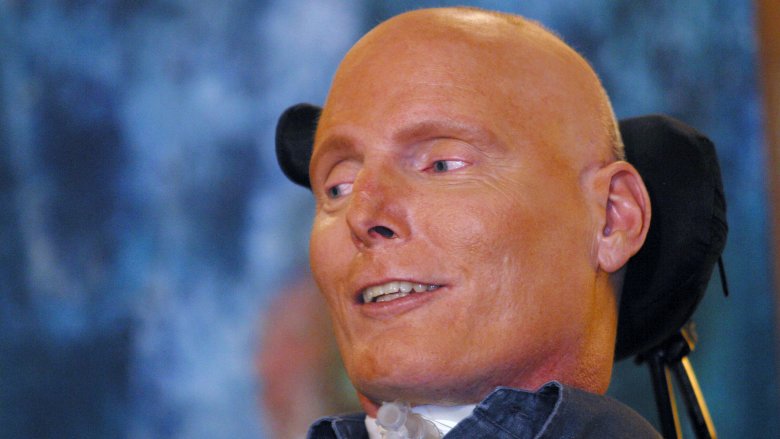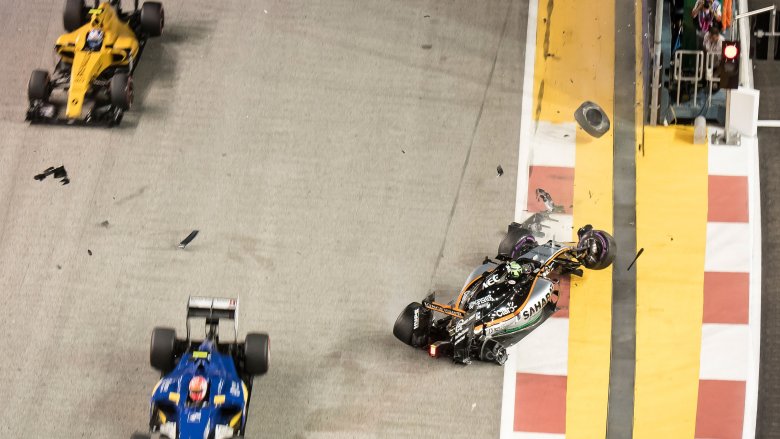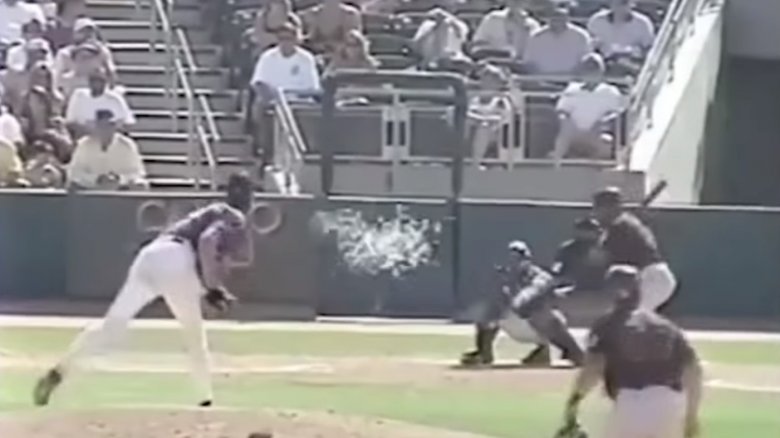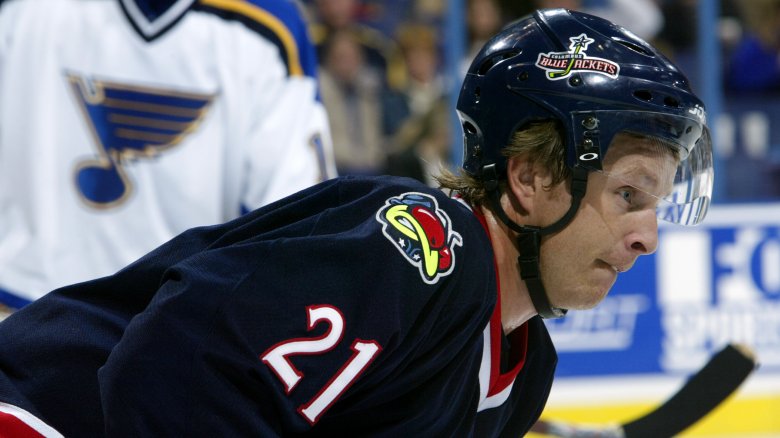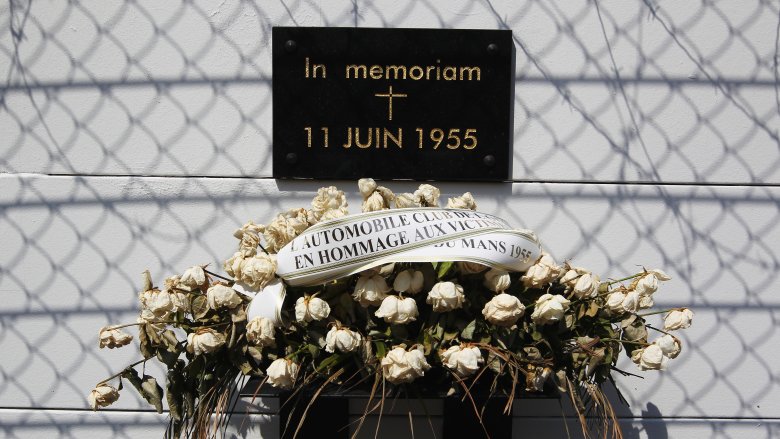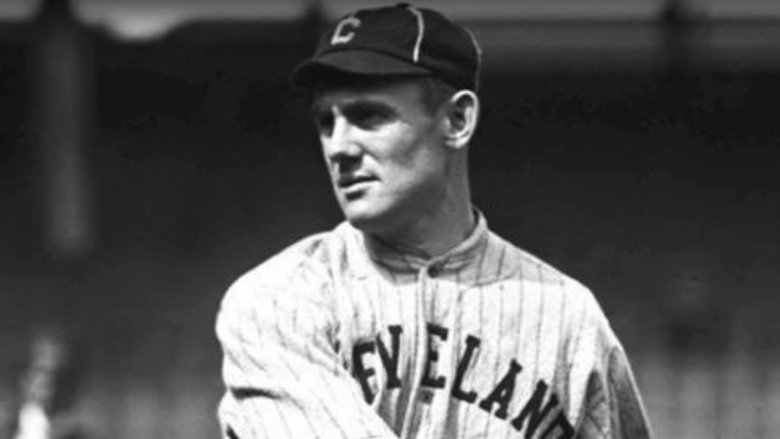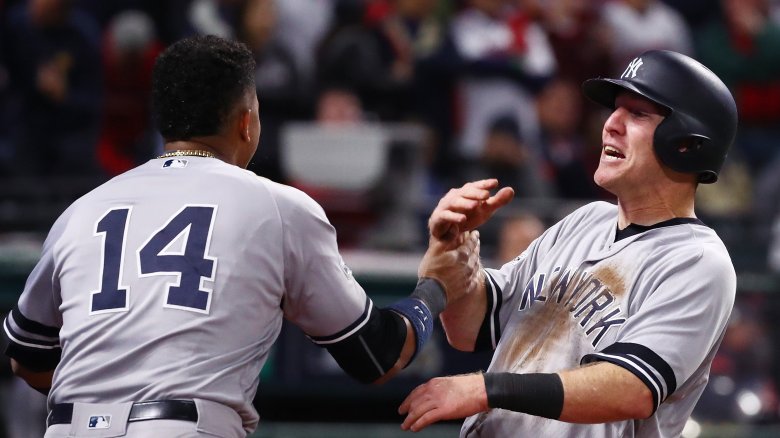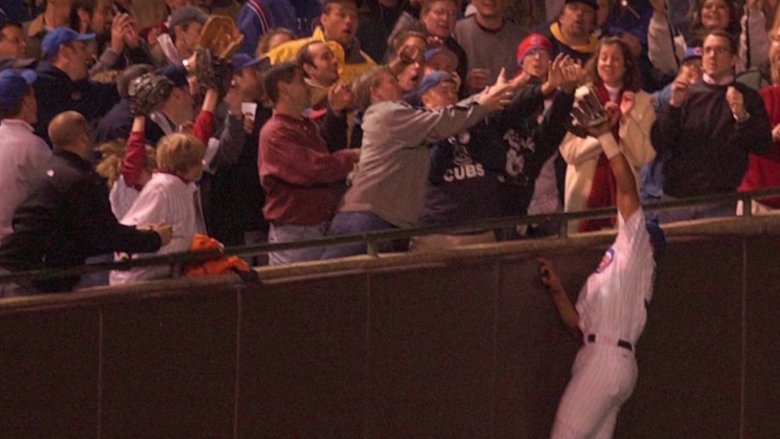Sports Mishaps That Destroyed Innocent Lives
We may receive a commission on purchases made from links.
Sports mean different things to different people. For some, they are a source of local pride. For others, an outlet. And for the unfortunate few, they become a scarring reminder that the world is just a malevolent ball of spinning chaos, tumbling through the void, waiting for its moment to strike and severely screw up your day.
Yes, the field of athletic excellence has long held the potential for tragedy. High-speed action and bodies in motion, plus the intense emotions of both players and fans make it next to impossible to prevent every potential opportunity for catastrophe. Folks trip and fall, sports equipment goes careening through the air, tempers fly, and mayhem ensues.
So grab a $9 beer, raise your voice lustily in the National Anthem, and get ready to read about some of the most atrocious misfortunes ever to strike the field, course, and stadium. Caveat emptor: Stuff gets graphic.
The tragic end of a beloved wrestler
Since its beginnings in the 19th century, Lucha Libre, or "free fighting," has become a colorful, bold chapter in Mexican cultural history. The brightly colored masks, larger-than-life personas, and high-flying acrobatic athleticism make it a hell of a spectacle. And as any three-fingered freeway kiosk fireworks salesman will tell you, with spectacle comes risk.
Exhibit A: Pedro Aguayo Ramírez, better known in the ring as Perro Aguayo Jr. As the son of famed wrestler Perro Aguayo, (naturally) he started wrestling at 15 and enjoyed a nearly 20-year career before his life was brought to an abrupt end in the ring.
During a 2015 match in Tijuana against Rey Mysterio Jr., Aguayo was drop-kicked into the ropes throat first. There was medical help on scene, but they didn't go straight to his side. In fact, he lay in the ring unconscious, the fight continuing briefly until someone noticed there was a problem. The official cause of death: He died of a heart attack caused by a stroke, which had been caused by a broken neck.
Christopher Reeve's superhuman struggle
Being Superman would be enough for most people, you know? Being immediately recognizable as one of the most popular characters in the history of Western civilization would be a solid slice of achievement pie for your average Joe. But for some reason, Christopher Reeve just kept getting good at other stuff, too.
Reeve had a fascinating life, attending Cornell and Juilliard before finding fame as the Man of Steel. When he wasn't acting, he pushed himself to impressive levels of achievement in other fields. He was a licensed pilot, a sailor, and an accomplished dressage horseback rider. And the end of that last sentence is where anyone alive and literate during the 1990s went "Ohhhhhh."
In 1995, Reeve was participating in a dressage event when his horse stopped mid-jump and threw him forward. He landed on his head, fractured his C1 and C2 vertebrae, and was paralyzed from the neck down. Reeve would never fully recover physically, but he continued to work for the rest of his life. His memoir, Still Me, spent 11 weeks as a New York Times bestseller, he appeared on Smallville and starred in a remake of Alfred Hitchcock's Rear Window, and he worked as a political activist until his death in 2004.
Calamity on the race course
A Formula 1 car is a sight to behold. For the uninitiated, it's a single seat race car capable of reaching speeds over 200 mph. Oh, and the cockpit is open, so the driver's body is just sort of out there. It's like if someone wanted all the velocity of a car mixed with everything about a motorcycle that can get you killed.
Needless to say, there have been some pretty horrifying accidents involving these machines. Drivers die with astonishing, bloodsport-like frequency. But some of the worst Formula 1 race incidents have involved the people who weren't behind the wheel.
Back in 2000, 33-year-old volunteer firefighter Paolo Gislimberti was working with the CEA Squadra Corse as an emergency responder at the FIA Formula 1 World Championship in Monza, Italy. During the first lap, there was a multiple-car collision that sent pieces of the vehicles flying at high speeds. Gislimberti was struck in the head and chest by a flying tire and died almost immediately. What's worse? He left behind a pregnant wife who gave birth to their daughter three months later.
An X Games catastrophe
Remember back in the 1990s and early 2000s when everything was extreme for a while? Big Gulps evolved into thirst-annihilating X-Treme gulps. The Ghostbusters, not content to let busting simply make them feel good, became the Extreme Ghostbusters and, presumably, got to feeling extremely good. We were taking things to the max, dog. It was extreme.
Enter the X Games: ESPN's answer to the question "What's the fastest way to paralyze white guys with dreadlocks?" and the Winter X Games, ESPN's answer to "same question as before, but on ice this time?"
At the 2013 Winter X Games in Aspen, 25-year-old Caleb Moore was competing in the snowmobile freestyle event. An experienced snowmobiler, Moore had already won several medals at previous X Games competitions, so it probably didn't seem like a huge deal when he tried to perform a backflip. Unfortunately, the skis at the front of his vehicle snagged on the ground when he landed, sending Moore over the handlebars and onto the ground. The snowmobile smashed into him, and he died a week later. He was presented with a posthumous X Games gold medal at his funeral, though. So, you know. Worth it.
This bird
There was a day in 2001 that, if you lived through it, you'll never forget. On that day, a tragedy occurred that distorted the landscape of an American icon. It changed history. It informed who we became as a nation. We refer here, of course, to that time that Randy Johnson threw a fastball that straight up disintegrated a bird.
The day? March 21, 2001. The place? Chase Field, the home stadium of the Arizona Diamondbacks. The Diamondbacks are playing the San Francisco Giants, and Randy Johnson is at the top of his game, warming up for what will be a 26-10 season. Giants batter Calvin Murray steps up to the plate. Johnson fires off a fastball. It's a magical thing, a properly executed fastball. There's just something about it that's downright American, like a beat-up truck driving down the freeway or Elmer Fudd.
And also like a fast-moving vehicle or Elmer Fudd, this ball exploded the living hell out of a bird.
In a coincidence that'd have the Douglas Adams Improbability Drive scratching its head and giving up for a while, a mourning dove flew across the field at exactly the right time to be struck by the pitch. A plume of feathers covered the field. The crowd? Aghast. The bird? Toast. The pitch? In a severely wasted moment, not called "fowl."
The devastating loss of Brittanie Cecil
Some safety features we just take for granted. Seatbelts in cars, for example. Carbon monoxide detectors. The safety netting at hockey games. Sadly, there's a reason these things exist: Tragedy strikes fast without them.
In March 2002, Brittanie Cecil was attending a Columbus Blue Jackets hockey game. She'd received tickets as an early present for her 14th birthday. Then, during the second period, the Blue Jackets' Espen Knutsen fired off a shot that was deflected by Calgary Flames defenseman Derek Morris. The puck ripped through the air, over the protective glass, and into the crowd, where it struck Brittanie in the left temple. Two days later, she died of complications from her injury.
In the aftermath of the accident, protective netting was made mandatory in all NHL arenas. The Blue Jackets wore Cecil's initials on their uniforms for the rest of the season, and Cecil's family received a settlement of over $1 million.
The 1955 Le Mans disaster
A lot can go wrong in auto racing. Dozens of cars loaded with chemicals designed to explode move at breakneck speeds for long stretches of time. Accidents are going to happen.
And as motorsports disasters go, you just can't beat the Le Mans car crash of 1955.
The 24 Heures du Mans, for those of us that fell asleep during French class, is a 24-hour race. It's brutal. The cars reach incredible speeds and maintain them for a full day. In the years following World War II, it became incredibly popular, drawing huge crowds. Put it all together and add the lack of safety standards back in the day and you've got a recipe for the horrific.
During the opening hours of the '55 Le Mans race, driver Pierre Levegh was doing a solid 125 mph when he crashed his car into the stands, slaughtering dozens of spectators. The exact number of deaths remains unknown, as the police records remain sealed, but estimates range between 60 and 130 casualties, including, according to first-hand accounts, people decapitated by the car's flying hood "like a guillotine."
The fatal fall of a dedicated father
Sometimes, things just go tragically wrong. In 2011, 39-year-old firefighter Shannon Stone took his 6-year-old son to a Texas Rangers baseball game. Reportedly, the kid had an abiding love for Rangers outfielder Josh Hamilton, so you can imagine the excitement the father and son felt when Hamilton tossed a ball to them from the field. Stone went to catch the ball, and tragedy struck.
Losing his footing, Stone tumbled forward over the balcony and landed, headfirst, on the concrete 20 feet below. An hour later, he was pronounced dead of severe blunt force trauma. His son witnessed the whole affair.
The next year, a statue depicting Stone and his son was unveiled and placed at the home plate entrance to the stadium. It was a bittersweet conclusion to an unimaginable tragedy, as two years later, the memorial made headlines when excited fans covered it in trash on opening day.
Electric mayhem
The world is a brutal, unfair place at times, and it's not unheard of for an entire sports team to be killed in a single unfortunate incident. Usually, these tragedies involve a bus or plane crash. But on one strange day that borders on unbelievable, a whole soccer team was killed by the wrath of Zeus. If that statement seems outdated and ridiculous, you ain't seen nothing yet.
In the Kasai province of the Democratic Republic of Congo, two soccer teams (or "football teams," if you want to get international — that's the least interesting part of the story by a wide stretch) were doing what they do: kicking a ball around, trying to score goals. Suddenly a freak lightning strike smashed into the field. Reportedly, 30 people received burns and 11 were killed. The kicker? All 11 of them were the members of one team.
A freak catastrophe, right? But what are you going to do? The world is unfair, and everyone moved on, made solemnly aware that some things are just outside of the scope of man's control.
Just kidding. The opposing team was accused of witchcraft.
Raymond Chapman sets horrible precedent
Helmets in sports: They're such a great idea. In baseball, for example, it's a given that you'd want to protect yourself from the compacted cork and leather rock getting hurled around at 100 mph. But we're not a species that learns without making mistakes, and it shows. Just look at Raymond Chapman.
If you're reading this, you've probably never seen Chapman play baseball. He was the shortstop for the Cleveland Indians in the early 20th century. According to Baseball: An Illustrated History, it was considered normal at the time for a pitcher to get the baseball as dirty and screwed up as possible before pitching it. The idea was to make the pitch's trajectory unpredictable. If this sounds stupid and dangerous, it's because it was.
By all accounts, the ball that did Ray Chapman in was good and disgusting when it flew off course and struck the 29-year-old right in the melon. Babe Ruth claimed he could hear the sound of the impact from all the way out in right field. Nearly a century later, Chapman remains the only player in MLB history to die of an injury sustained during a game.
became the only player in major league history to die of an injury received during a game when he was struck in the head by a fastball in 1920.
Yankees v. toddler
Let's start with the good news: The toddler survived. Alright, on to the gruesome details.
On September 20, 2017, a 2-year-old girl (whose name has been withheld due to concerns about her privacy) was attending a Yankees game with her grandparents and her older brother. They were seated behind the third base dugout. Yankees third baseman Todd Frazier was up to bat, and hit a line drive foul ball into the stands. The ball was clocked at 105 mph as it ripped through the air, giving the child's grandpa practically no time to respond. The ball smashed square into the center of the little girl's face, fracturing her skull and leaving an imprint of the ball's stitching in her skin.
Luckily, there was a doctor sitting in the same section as the horrified family. Thanks in large part to immediate assistance and the quick response from EMTs, the little girl made it out alive. She was released five days later, but according to her family, she still puts ice packs on her dolls' heads because "they got hit in the head by a baseball." All 30 MLB teams extended their protective netting farther around their fields after the tragic incident.
Don't do the Bartman
Sometimes, you can make a mistake so fast that you don't even realize it's happening. Case in point: the Legend of Bartman.
It was Game 6 of the National League Championship Series in 2003. The Cubs were up 3-0 against the Marlins in the eighth inning, and it was starting to look like they had a shot at the National League pennant for the first time in nearly 60 years. The game was nearly a sure thing. How often does a team lose with a 3-0 lead in the eighth? Well ... often enough.
Smash cut to: Louis Castillo of the Marlins hits a foul ball. It makes its way toward the stands. Chicago outfielder Moisés Alou runs for the ball. He leaps into the air. And then?
A Cubs fan in a turtleneck slaps it out of reach.
Look, it was an easy mistake to make. The offending party, Steve Bartman, later said in a statement that he just got caught up in the moment and didn't even notice Alou was trying to make the catch. Plus, two other fans tried to make the same catch, like almost any fan would. The players lost their composure, paving the way for the Marlins to make a comeback and win the game 8-3. Bartman had to be escorted out of the stadium for his own safety. He wound up with cops guarding his home after his personal information became public. When the Cubs finally did win a World Series in 2017, Bartman received a championship ring from the team as an apology.


